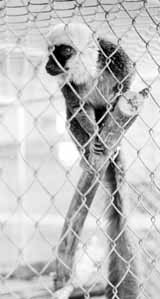Cold weather doesn’t shut down local zoo
Even during the winter, the Willow Park Zoo is up and running.
The zoo has had some milder winters the last few years, and has not worried about most of the animals, said curator Rod Wilhelm, a 24-year veteran of the zoo. Many of them, such as the tortoises, tropical birds and monkeys, are simply brought indoors.
Former zoo employee Michael Saunders remembers that a major part of winter is feeding the birds of prey. When the zoo received phone calls regarding free food, it was Saunders’ job to pick it up.
“We would pick up roadkill deer, quarter them and feed the hawks and owls, because [birds of prey] need fresh red meat,” Saunders said.
In its 33rd year, Willow Park houses more than 100 species of birds, 12 species of mammals and various tortoises and fish. The most irreplaceable animal at the zoo is the Andean Condor, Wilhelm said. It was listed as an endangered species in 1973.
The zoo has more than 40 species of waterfowl, with many from South America, Europe, Asia and Australia. One exhibit features Australian animals, including wallabies.
The elk are the most popular attraction, Wilhelm said, but not the rarest. People drive by often to see the big six-point bull. Elk are also the most expensive to feed, because of the volume of food they require. Other animals are also costly to feed, such as the lemurs, bobcats, coyotes and red foxes, because of their exotic diets.
Cold winters keep people away, but do not affect most animals. Wilhelm prefers Utah’s normal winters, because when it is unseasonably warm, the migration season starts too early for comfort.
“Pairing and migration start too early — a month or two ahead of schedule. There’s a lot of egg production lost with some animals,” Wilhelm said. “Mallards will produce another clutch of eggs, but Canada geese for instance, normally will not.”
Sometimes, visitors feel a need to feed the critters, especially in winter.
“One of the biggest problems of animals in zoos can be obesity from people feeding them,” Wilhelm said.
For example, there is not enough nutritional value in bread, Wilhelm said. People want to throw bread pieces to the ducks and geese, and like children, birds will eat whatever is given to them.
“It’s like your kids — would you throw them what they like or what they need?” Wilhelm said.
Also, the food can be unsafe for birds. Birds can choke on popcorn. Plus, the birds do not need the salt; they get enough in their natural diet.
So, for 10 cents, people buy morsels of food to feed the birds. Zoo visitor Vernon Post appreciates that part of Willow Park and said it is fun for his grandchildren.
“I like the duck pond where you can feed them,” Post said.
Zoo regular Holly Wamsley, 23, enjoys her children’s interaction with the animals. She has three children who are regular visitors at Willow Park Zoo.
“Last summer, [we came] every other week,” Wamsley said.
Another important thing is to try to maintain the natural state of the animals. Visitors complain when they don’t see the bobcats, the fallow deer and other “unfriendly” animals. Wilhelm tells people that some animals are less sociable to humans than others. If people are patient, maybe the more reclusive species will eventually come to them.
Wilhelm mentioned some ways people can help animal populations. Although he no longer hunts big game, Wilhelm said hunting benefits wildlife in general.
“Unless we manage the wildlife, we shouldn’t be here. Hunting contributes more to wildlife and wildlife management than anything else financially,” he said.
Of course, zoos exist to preserve animals and let the public see them up close.
“We don’t take care of animals so they can be hunted,” Wilhelm said.
More often than letting animals go, Willow Park trades animals with other zoos to keep the bloodlines fresh. And of course, some animals die of natural causes.
Willow Park Zoo has no admission fee, but suggests a 25-cent donation. The city and county finance the zoo, and sometimes the state gives funding. But with 120,000 visitors a year, the yearly donations add up to almost $9,000. So every quarter helps, Wilhelm said.
The zoo is open every day from 9 a.m. to dusk.
–marklaroc@cc.usu.edu

The lemur, a member of the primate family, is one of several animals at the Willow Park Zoo that spends the winter indoors. (Photos by Angelie Christensen)

